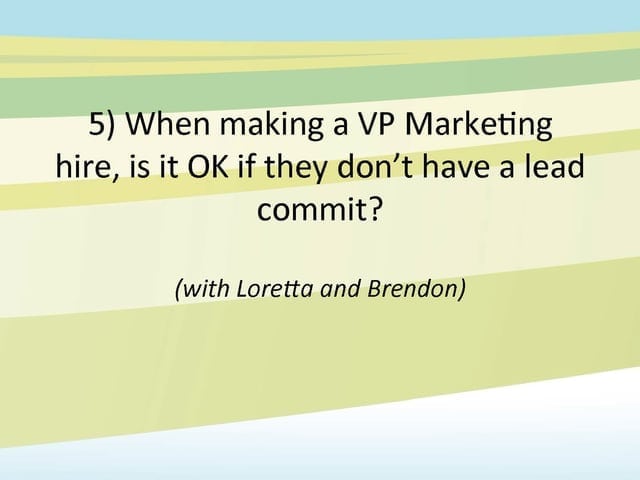- Like
- SHARE
- Digg
- Del
- Tumblr
- VKontakte
- Flattr
- Buffer
- Love This
- Save
- Odnoklassniki
- Meneame
- Blogger
- Amazon
- Yahoo Mail
- Gmail
- AOL
- Newsvine
- HackerNews
- Evernote
- MySpace
- Mail.ru
- Viadeo
- Line
- Comments
- Yummly
- SMS
- Viber
- Telegram
- JOIN
- Skype
- Facebook Messenger
- Kakao
- LiveJournal
- Yammer
- Edgar
- Fintel
- Mix
- Instapaper
- Copy Link
 A ways back, we did an extremely popular post entitled, Hire the Right Type of VP Marketing or You’ll Just End Up With a Bunch of Blue Pens with Your Logo On Them. The basic idea was to help folks who haven’t hired a VP or Director of Marketing hire the right one for a pre-Scale sales-driven SaaS company. Someone that knows, lives and breathes leads, funnels and funnel management, drip marketing, and all the rest. Someone who knows how Marketo and Hubspot actually work, how to deploy capital and measure CAC, who knows how the whole playbook from first touch to money works, as a science.
A ways back, we did an extremely popular post entitled, Hire the Right Type of VP Marketing or You’ll Just End Up With a Bunch of Blue Pens with Your Logo On Them. The basic idea was to help folks who haven’t hired a VP or Director of Marketing hire the right one for a pre-Scale sales-driven SaaS company. Someone that knows, lives and breathes leads, funnels and funnel management, drip marketing, and all the rest. Someone who knows how Marketo and Hubspot actually work, how to deploy capital and measure CAC, who knows how the whole playbook from first touch to money works, as a science.
And most importantly … someone who knows how to deliver leads. A Lead Commit. Or if you want to go a stage further down the funnel, an Opportunity Commit. An “Opportunity Commit” works well for bigger ACVs ($20k+) in my experience and less well for small deals). Or sometimes an SAL commit (Sales Accepted Lead). Or SQL commit. It matters less exactly what the commit is … than that there actually is one.
I want to bring this up again because I interview so many VP/head/director of marketing candidates. And these days, they all can talk the talk. “Positioning”. “MQLs”. “Demand generation”. Blah blah blah.
But can they actually do it? You can find out pretty quickly if your VP of Marketing candidate can deliver leads (and thus, hopefully, increase your revenue growth rate) with just 2 or 3 questions:
- Question #1: What Was Your Lead / Opportunity Commit At Your Last Company? Again, it might be leads, or opportunities, or accounts, or whatever. But whatever it was — if the candidate can’t answer this question fluently, without stumbling, in about 60 seconds … she or he didn’t really “own a number”. I’d pass. And ask how was it determined. It doesn’t matter exactly how. Did the CEO pick it? The VPM together with VPS? who knows. But learning how they decided this #1 KPI and metric from your VPM will teach you a lot about if he can actually do it. Again, you’d be surprised how many candidates will stumble and say “I don’t know how the lead commit was determined.” Pass.
- Question #2: I Want to Hit $Xm in ARR By Year-End. What Should We Do In the First 90 Days to Kick That Off? A great VP of Marketing won’t actually know the answers yet. But if you give her your raw data — she will start working through the math. Average deal size, close rates, current growth rate, incremental growth required to hit the number … and she’ll have a very rough plan and some good ideas. And I sure hope that plan doesn’t start with a “brand review” for 30 days. It should start with figuring out how to grow leads Y% so you can create the incremental growth required to hit the plan.
- Question #3: How should marketing and sales work together to hit this plan? This is sort of a catch-all. You’d be surprised how many candidates don’t see the roles as connected. If not … I’d pass every time. Your VP of Marketing and VP of Sales need to be your Dad and Mom of Revenue in your company. More on that here. And go further before you make the hire. Talk the VP of Sales he or she worked with. See if they’d recommend her. And exactly what sort of leads … they delivered.
Try these three questions. You’ll be shocked how many “head of marketing” candidates you’ll talk to fail them. If they pass this test, if the answers sound right-ish to you … you may have someone good.
But if you want more revenue and leads … and not just blue pens with your logos on them … and the candidate never really owned that metric, a true lead commit … it just never works out.
………..
More and more detail on the topic from the SaaStr Spring Soiree in the video below:
Good leads image from here
(note: an updated SaaStr Classic post)
A related, deeper dive here:


